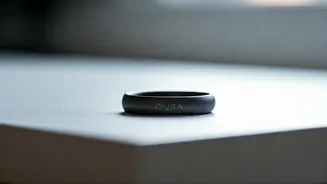Beyond the Screen
The contemporary fitness landscape is largely defined by devices featuring screens, from smartwatches to fitness bands. These gadgets provide immediate
access to data, encouraging users to track their activity levels. However, screenless wearables, such as the Whoop band and Oura ring, are emerging as a contrasting option. These devices collect data discreetly, aiming to provide insights without requiring users to continuously check a screen. This approach provides an opportunity for individuals seeking a more subtle and less distracting approach to health monitoring, offering a blend of modern technology with a minimalist design.
Whoop vs Oura
Whoop bands and Oura rings exemplify the features of screenless wearables, though they differ slightly in their design and functionality. Whoop, a band worn on the wrist, excels at tracking strain, recovery, and sleep metrics, delivering comprehensive insights into a user's fitness state. Conversely, Oura rings prioritize comfort and wearability, discreetly monitoring sleep quality, body temperature, and activity levels from the finger. The key distinction lies in the form factor and specific data emphasis. While Whoop provides broader health metrics, Oura focuses on sleek design and detailed sleep analysis, appealing to users with different preferences.
How They Work
Screenless wearables utilize an array of sensors to gather a wealth of data. They typically employ accelerometers, gyroscopes, and heart rate sensors to track movement, heart rate variability, and other important physiological metrics. This data is then synced with a companion app on a smartphone, where users can see in-depth analysis, personalized recommendations, and progress tracking. By removing the immediate screen, these devices encourage the user to maintain focus on their routine while passively gathering data, offering a more integrated health management experience.
Discreet Benefits
One of the major draws of screenless wearables is their discreet nature. They avoid the constant interruptions associated with smartwatches and fitness trackers, allowing users to remain present in their daily activities. This is particularly beneficial for those who find screen notifications distracting. The subtle design of these devices also appeals to individuals who prioritize a more minimalist aesthetic. Ultimately, screenless wearables aim to seamlessly integrate health tracking into daily life, helping users focus on their well-being without making it a distraction.
User Experience
The user experience of screenless wearables revolves around the supporting smartphone app. Data from the wearable is sent automatically to the app where users can examine trends, understand insights, and receive personalized advice. The interface is usually user-friendly, providing easy-to-understand visualizations of health data. However, the reliance on an external app means users must regularly check their phones to monitor their data. The appeal of these devices lies in their capacity to collect comprehensive data, giving a subtle and comprehensive approach to fitness and health that does not require constant attention.
Future Trends
The trend of screenless wearables highlights a shift towards a more subtle approach to health tracking. As technology evolves, we can anticipate more advanced sensors, improved accuracy, and enhanced data analysis capabilities. The incorporation of additional health metrics and deeper personalized insights is also likely. The future may see even more innovative form factors and designs, further blurring the lines between technology and everyday life. The objective is to give users a simple way to take charge of their health while blending seamlessly into their daily routine, reinforcing the growing interest in discreet and user-friendly devices.











